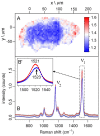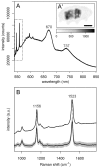Nature, source and function of pigments in tardigrades: in vivo raman imaging of carotenoids in Echiniscus blumi
- PMID: 23185564
- PMCID: PMC3503987
- DOI: 10.1371/journal.pone.0050162
Nature, source and function of pigments in tardigrades: in vivo raman imaging of carotenoids in Echiniscus blumi
Abstract
Tardigrades are microscopic aquatic animals with remarkable abilities to withstand harsh physical conditions such as dehydration or exposure to harmful highly energetic radiation. The mechanisms responsible for such robustness are presently little known, but protection against oxidative stresses is thought to play a role. Despite the fact that many tardigrade species are variously pigmented, scarce information is available about this characteristic. By applying Raman micro-spectroscopy on living specimens, pigments in the tardigrade Echiniscus blumi are identified as carotenoids, and their distribution within the animal body is visualized. The dietary origin of these pigments is demonstrated, as well as their presence in the eggs and in eye-spots of these animals, together with their absence in the outer layer of the animal (i.e., cuticle and epidermis). Using in-vivo semi-quantitative Raman micro-spectroscopy, a decrease in carotenoid content is detected after inducing oxidative stress, demonstrating that this approach can be used for studying the role of carotenoids in oxidative stress-related processes in tardigrades. This approach could be thus used in further investigations to test several hypotheses concerning the function of these carotenoids in tardigrades as photo-protective pigments against ionizing radiations or as antioxidants defending these organisms against the oxidative stress occurring during desiccation processes.
Conflict of interest statement
Figures




Similar articles
-
Atlas of the Echiniscidae (Heterotardigrada) of the Worldpart I: West Palaearctic Echiniscus species.Zootaxa. 2023 Sep 14;5344(1):1-72. doi: 10.11646/zootaxa.5344.1.1. Zootaxa. 2023. PMID: 38221356
-
Surface enhanced Raman scattering on Tardigrada--towards monitoring and imaging molecular structures in live cryptobiotic organisms.J Biophotonics. 2013 Oct;6(10):759-64. doi: 10.1002/jbio.201200206. Epub 2012 Dec 7. J Biophotonics. 2013. PMID: 23225705
-
Inorganic ion composition in Tardigrada: cryptobionts contain a large fraction of unidentified organic solutes.J Exp Biol. 2013 Apr 1;216(Pt 7):1235-43. doi: 10.1242/jeb.075531. Epub 2012 Dec 13. J Exp Biol. 2013. PMID: 23239888
-
On dormancy strategies in tardigrades.J Insect Physiol. 2011 May;57(5):567-76. doi: 10.1016/j.jinsphys.2011.03.003. Epub 2011 Mar 21. J Insect Physiol. 2011. PMID: 21402076 Review.
-
Survival in extreme environments - on the current knowledge of adaptations in tardigrades.Acta Physiol (Oxf). 2011 Jul;202(3):409-20. doi: 10.1111/j.1748-1716.2011.02252.x. Epub 2011 Mar 22. Acta Physiol (Oxf). 2011. PMID: 21251237 Review.
Cited by
-
Analysis of DNA repair and protection in the Tardigrade Ramazzottius varieornatus and Hypsibius dujardini after exposure to UVC radiation.PLoS One. 2013 Jun 6;8(6):e64793. doi: 10.1371/journal.pone.0064793. Print 2013. PLoS One. 2013. PMID: 23762256 Free PMC article.
-
Deciphering the Biological Enigma-Genomic Evolution Underlying Anhydrobiosis in the Phylum Tardigrada and the Chironomid Polypedilum vanderplanki.Insects. 2022 Jun 19;13(6):557. doi: 10.3390/insects13060557. Insects. 2022. PMID: 35735894 Free PMC article. Review.
-
Does pigmentation provide protection to bdelloid rotifers in a high ultraviolet B environment?Limnol Oceanogr. 2024 Nov;69(11):2688-2701. doi: 10.1002/lno.12710. Epub 2024 Oct 6. Limnol Oceanogr. 2024. PMID: 40453987
-
Green armoured tardigrades (Echiniscidae: Viridiscus), including a new species from the Southern Nearctic, exemplify problems with tardigrade variability research.Sci Rep. 2023 Sep 28;13(1):16329. doi: 10.1038/s41598-023-40609-4. Sci Rep. 2023. PMID: 37770488 Free PMC article.
-
Patterns of sexual dimorphism in the armoured tardigrades.Biol Lett. 2024 Sep;20(9):20240301. doi: 10.1098/rsbl.2024.0301. Epub 2024 Sep 11. Biol Lett. 2024. PMID: 39255843
References
-
- Rebecchi L, Altiero T, Guidetti R (2007) Anhydrobiosis: the extreme limit of desiccation tolerance. Invertebr Surv J 4: 65–81.
-
- Guidetti R, Altiero T, Rebecchi L (2011) On dormancy strategies in tardigrades. J Insect Physiol 57: 567–576. - PubMed
-
- Jönsson KI, Rabbow E, Schill RO, Harms-Ringdahl M, Rettberg P (2008) Tardigrades survive exposure to space in Low Earth Orbit. Curr Biol 18: R729–R731. - PubMed
-
- Rebecchi L, Altiero T, Guidetti R, Cesari M, Bertolani R, et al. (2009) Tardigrade Resistance to Space Effects: first results of experiments on the LIFE-TARSE mission on FOTON-M3 (September 2007). Astrobiology 9: 581–591. - PubMed
-
- Altiero T, Guidetti R, Caselli V, Cesari M, Rebecchi L (2011) Ultraviolet radiation tolerance in hydrated and desiccated eutardigrades. J Zool Syst Evol Res 49: 104–110.
Publication types
MeSH terms
Substances
LinkOut - more resources
Full Text Sources
Medical

